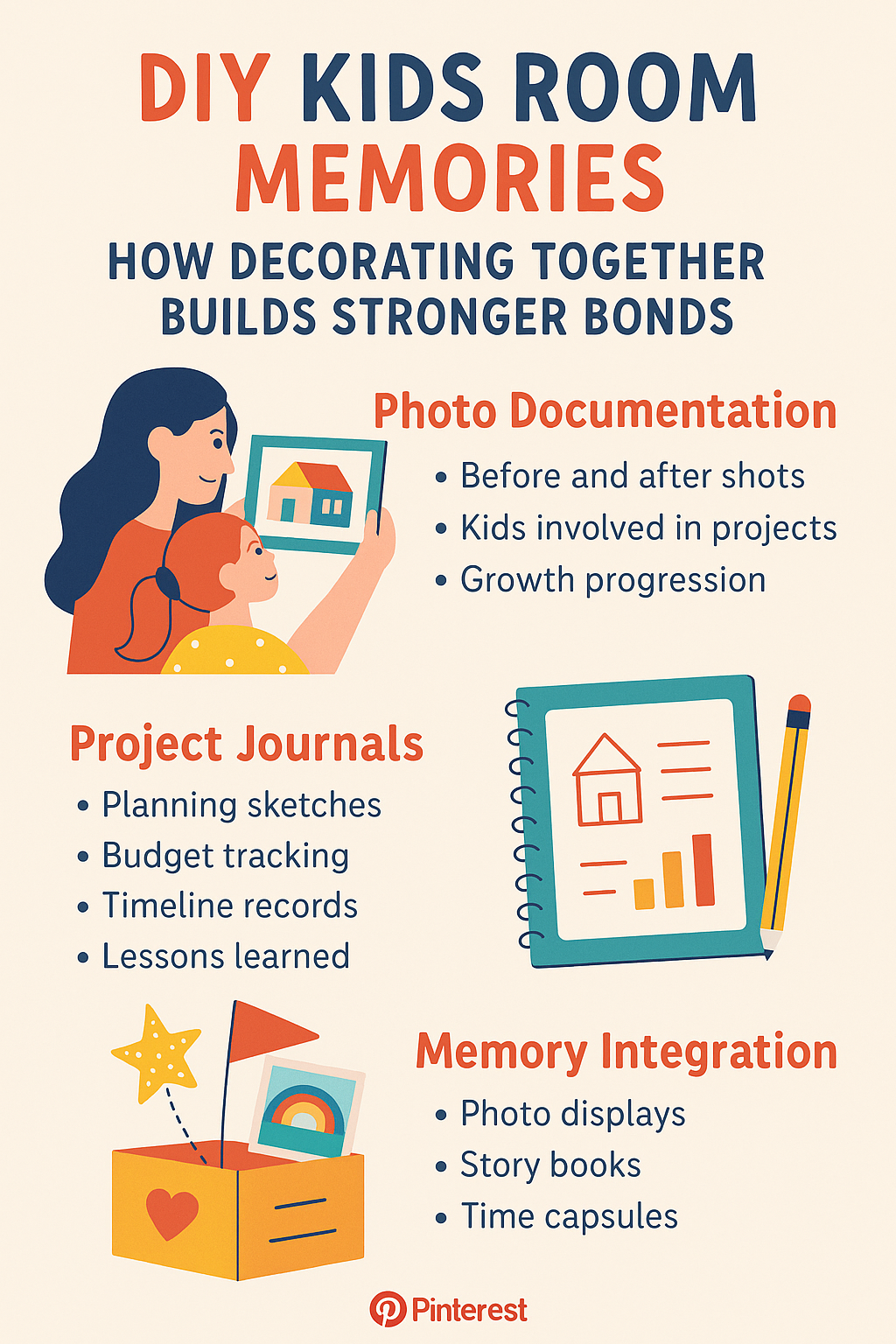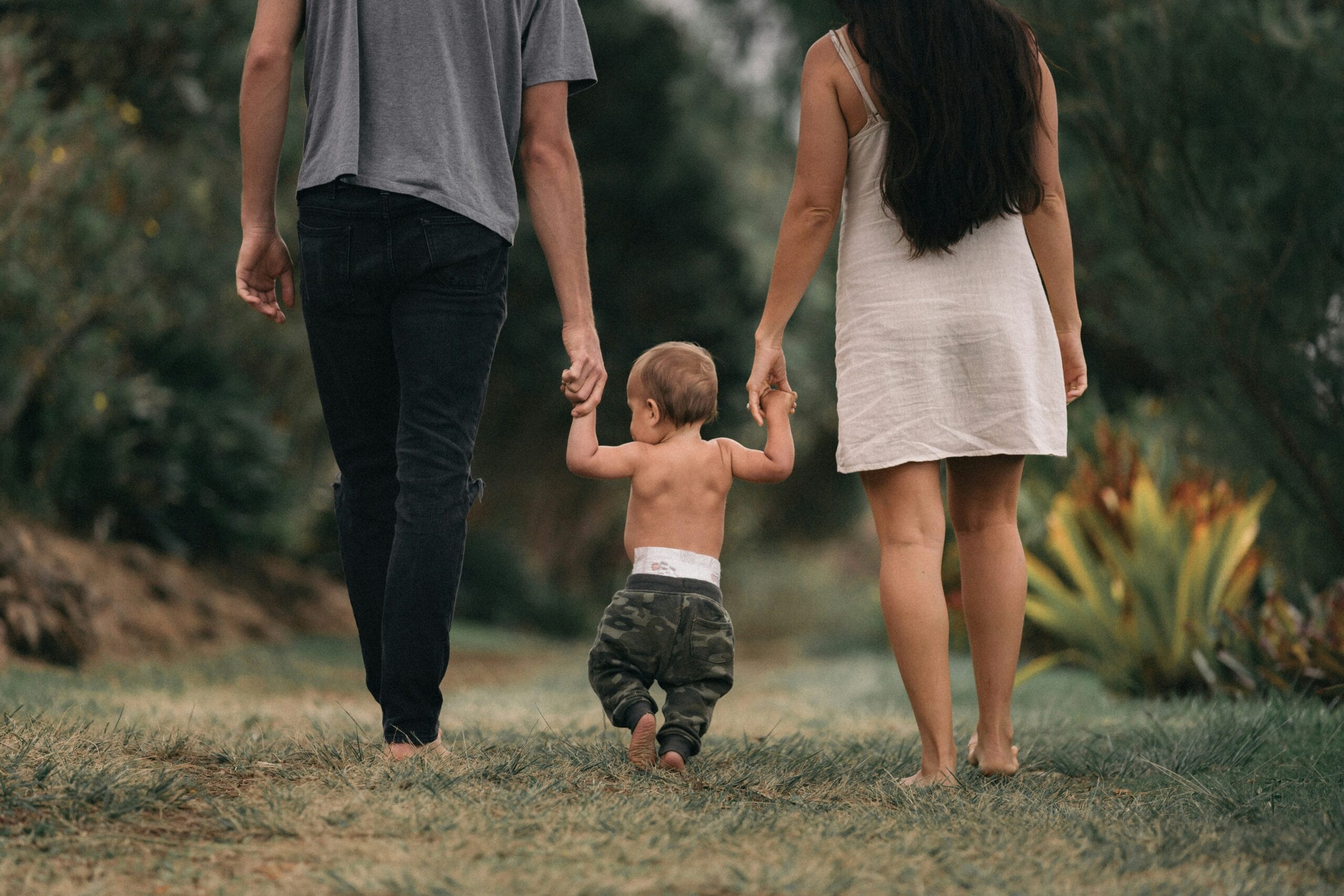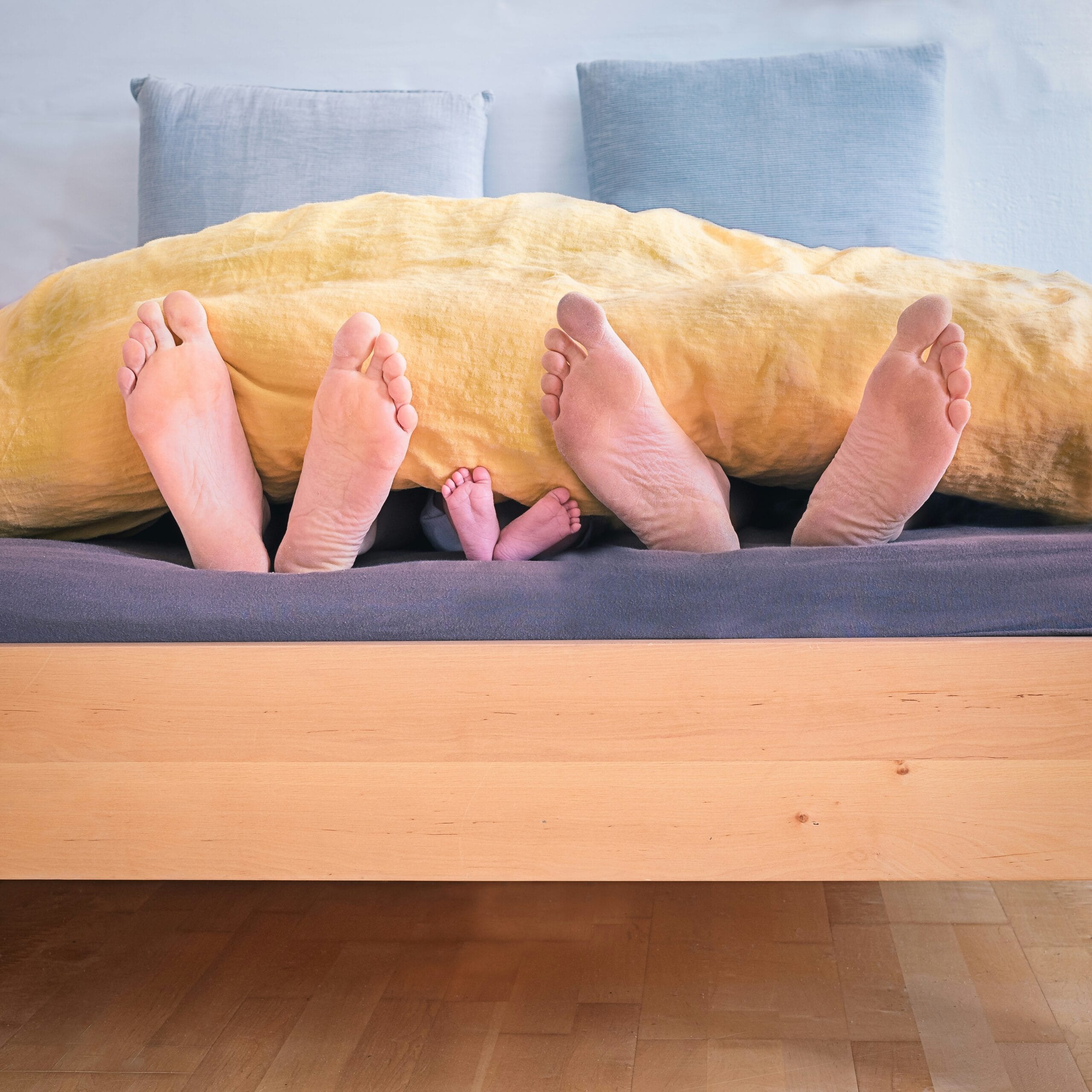15 DIY Kids Room Ideas That Transform Spaces on Budget 🎨
The internet is FILLED with designs and how-to’s about the “perfect” bedroom for you and your children, displaying the picture perfect photo with sleek paint lines and toys meticulously placed. Sure, this is wonderful if you’re trying to grab attention of the next sponsor (or keep one), but how many actually portray real families?

How many of those rooms do you see with toddlers running around happily, with the trend of bright whites and sanitized furniture and decor?
Bring back your inner child! 🌈
Enough of being afraid the world will judge you based off of a messy room pic. Let kids be kids and their rooms be as vibrant as they are. As a father of six (five amazing girls and one incredible boy), I’ve learned that the most magical kids’ spaces aren’t the ones featured in magazines – they’re the ones where creativity flows freely and DIY kids room ideas come to life through family collaboration.
After 20+ years of marriage and countless room transformations (trust me, with six kids, you become an expert at budget-friendly kids bedroom solutions), I’ve discovered that the best spaces are created when we throw perfectionism out the window and embrace the beautiful chaos of childhood.
Why DIY Kids Room Ideas Beat Store-Bought Perfection 💫
Here’s the thing – those Pinterest-perfect rooms look stunning for about five minutes. Then real life happens. Your daughter decides the white walls need a mural of her pet hamster. Your son determines that action figures look better displayed on every available surface than neatly tucked away in bins.
And you know what? That’s beautiful.
When my oldest daughter Natalie was seven, she wanted her room to look like a “princess castle meets art studio.” Instead of buying expensive themed furniture that she’d outgrow in two years, we got creative with DIY children’s bedroom decorating projects that evolved with her personality.
The result? A space that told her story, reflected her interests, and – most importantly – felt like home.

Creative Children’s Room Decor That Grows With Your Kids 🎯
One of the biggest mistakes parents make (and trust me, I’ve made plenty) is creating a room so themed or “finished” that there’s no room for growth. Kids change faster than you can say “Frozen merchandise,” so your kids room makeover ideas need to be adaptable.
Here’s what I’ve learned works:
Foundation First: Start with neutral walls and floors that can handle change. That hot pink your daughter must have today? Make it an accent wall, not the entire room. When she discovers her love for science next year, you’re not repainting the whole space.
Flexible Furniture: Invest in quality pieces that serve multiple functions. A sturdy desk becomes a craft station, homework hub, and display area for treasures. Storage ottomans provide seating and toy organization.
Display Systems: Create ways to showcase their evolving interests. Gallery walls with easily changeable frames, cork boards for artwork rotation, and shelving that adapts to different collections.
Budget-Friendly Kids Bedroom Magic: Where to Start 💰
Let’s be real – kids don’t need expensive furniture to be happy. Some of our most successful budget-friendly kids bedroom transformations came from thrift store finds, DIY projects, and pure creativity.
Start with these low-cost, high-impact changes:

Paint Power 🎨
Nothing transforms a space faster than paint. But here’s the twist – let your kids help choose AND apply it (within reason). We’ve created:
- Chalkboard walls for endless creativity
- Accent walls in their current favorite color
- Simple geometric patterns using painter’s tape
- Even handprint borders that become treasured memories
Lighting Magic ✨
Fairy lights aren’t just for Instagram – they create genuine warmth and wonder. String them around bed frames, create reading nooks, or outline doorways. For under $20, you can completely change the mood of any room.
My middle daughter Kaelyn strung lights around her desk area when she was 12, creating her own “study sanctuary.” Three years later, she still loves that cozy corner, even though everything else in her room has evolved.
Storage Solutions That Don’t Suck 📦
Kids have stuff. Lots of it. Instead of fighting this reality, embrace it with creative storage that doubles as decor:
- Colorful bins that slide under beds
- Wall-mounted organizers made from repurposed materials
- Ottoman storage that provides extra seating
- Hanging nets for stuffed animals (gets them off the floor but keeps them visible)
Top 15 DIY Kids Room Ideas That Actually Work 🛠️
After years of trial and error (and a few Pinterest fails), here are the DIY kids room ideas that have stood the test of time in our house:
1. Create a Gallery Wall for Rotating Art 🖼️
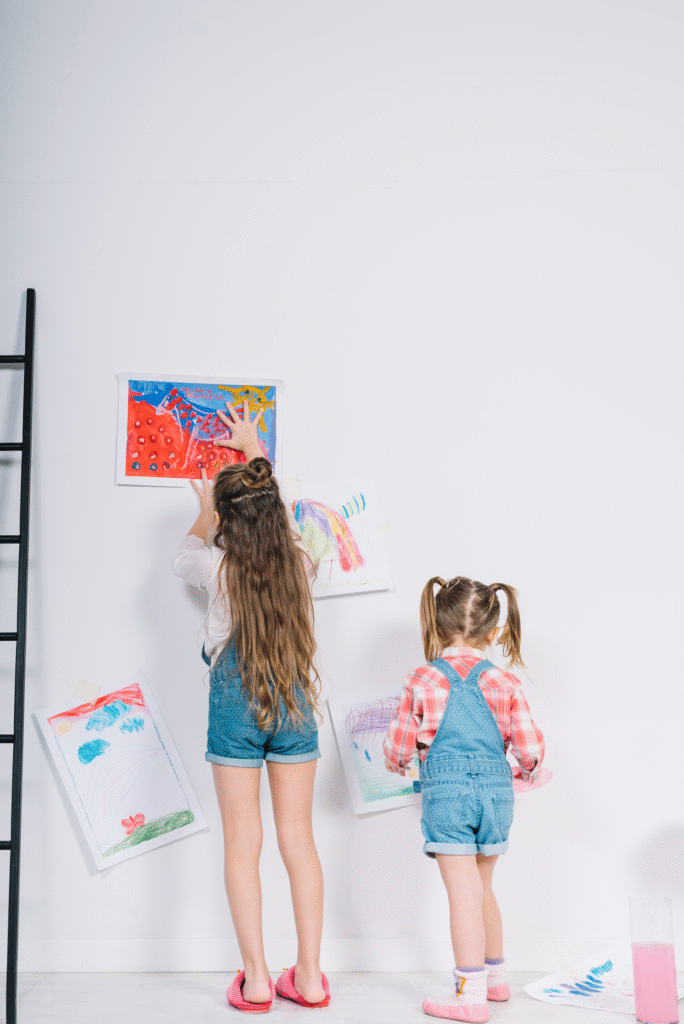
Instead of covering the fridge with artwork, create a dedicated gallery space in their room. Use frames from dollar stores, paint them in coordinating colors, and rotate the displays monthly. This teaches kids to value their creations while keeping the visual clutter manageable.
Pro tip: Include a mix of their art, family photos, and inspirational quotes. My youngest daughter Gabrielle loves having her latest masterpiece displayed next to a family vacation photo.
2. Build a Reading Nook 📚
Every child needs a cozy retreat. This doesn’t require major construction – we’ve created magical reading corners using:
- Floor pillows and soft blankets
- String lights for ambiance
- Small bookshelf within reach
- Sometimes just a tent made from sheets and chairs
The key is making it feel special and separate from the rest of the room. Building healthy family routines often starts with creating spaces that encourage positive habits like reading.
3. Design a Custom Growth Chart 📏
Skip the store-bought versions and create something meaningful. We’ve made growth charts from:
- Vintage yardsticks
- Painted wooden boards with family member names at their heights
- Tree designs where each ring represents a year
- Even a simple painted ruler design on the wall
Bonus: Include markers for other family members, pets, or special milestones. It becomes a family history lesson disguised as decoration.
4. Install a Chalkboard Wall ✏️
This might be the best investment we’ve ever made in kids’ rooms. Chalkboard paint allows children to “draw or write on the wall freely and adds an interactive element to the room.”
We’ve used chalkboard paint on:
- One full wall (for dramatic effect)
- Inside closet doors (hidden creativity space)
- Sections of walls (more manageable)
- Even the backs of dressers
Safety note: Most chalkboard paints installed by interior painters are non-toxic. However, it’s still a good idea to ask. Make sure it is non-VOC, which stands for “volatile organic compound.” Always choose child-safe, low-VOC options for any DIY children’s bedroom decorating projects.
5. Create Themed Bedding DIY Style 🛏️
Instead of buying expensive character bedding that they’ll outgrow, get creative with:
- Plain colored sheets with DIY pillowcases
- Fabric markers for custom designs
- Iron-on patches for current interests
- No-sew fleece blankets in their favorite colors
My daughter Melody went through a space phase, so we took plain navy sheets and added glow-in-the-dark stars. When her interests shifted to music, we simply swapped the pillowcases for ones with musical notes.
6. Build Simple Floating Shelves 📐
These provide display space without eating up floor area. Perfect for:
- Trophy collections
- Books
- Small plants (if your kids are old enough)
- Rotating seasonal decorations
Safety note: Always anchor properly into wall studs, especially in kids’ rooms where climbing might happen.
7. Design a Dress-Up Storage Solution 👗

Here’s an excellent DIY solution from Learn with Play at Home.
For kids who love costumes and role-playing, create a mini “closet” using:
- Tension rods in corners
- Decorative hooks at kid height
- Small dresser or basket for accessories
- Mirror for admiring the final look
This keeps the costumes organized while encouraging imaginative play.
8. Make a Memory Board 🎯
Using cork board or fabric-covered foam board, create spaces for:
- Photos with friends
- Achievement certificates
- Ticket stubs from family outings
- Inspirational quotes
- Current goals or dreams
Update regularly to keep it relevant to their current life.
IKEA Hack Storage Solutions 📦
Let’s be honest – IKEA is the parent’s secret weapon for affordable, functional budget-friendly kids bedroom storage. Here are our tested-and-approved hacks:
TROFAST System Magic: This modular storage is perfect for toy organization. “The sturdy wooden frames hold lightweight plastic boxes that your child can easily slide out, carry to where the fun is and put back again.” We’ve turned TROFAST units into:
- Dedicated LEGO building stations
- Art supply organization centers
- Dress-up costume storage
- Book and puzzle libraries
KALLAX Cube Creativity: These cube shelves work for any age and adapt as kids grow. Add fabric bins for younger kids, open shelving for older ones who want to display collections.
RÅSKOG Cart Adventures: “Initially designed for kitchen storage, the RÅSKOG trolley is also the perfect portable art trolley.” We use these rolling carts for:
- Mobile art stations
- Bedtime book collections
- Homework supply organization
- Toy rotation systems
Under-Bed Storage Wins: Utilizing the area under the bed is “the smartest and easiest way to store items without cluttering your child’s room.” Perfect for seasonal clothes, extra bedding, or toys that aren’t used daily.
10. Create a Homework Station ✏️
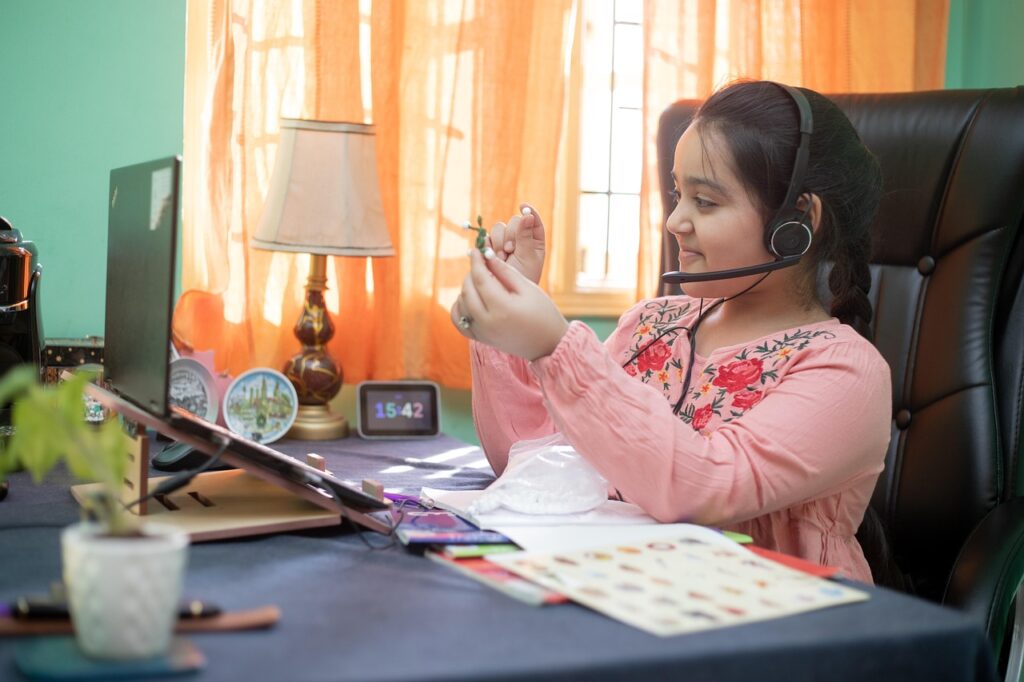
Even young kids benefit from a designated work area:
- Good lighting (natural light when possible)
- Storage for supplies within reach
- Comfortable seating
- Minimal distractions
This doesn’t need to be elaborate – we’ve created successful homework stations using everything from repurposed dining chairs to exercise balls for kids who need to move while thinking.
11. Design Wall Decals (The Removable Kind) 🌟
You can make your own using:
- Vinyl adhesive sheets
- Cookie cutters as templates
- Computer cutouts
- Hand-drawn designs
12. Build a Fort-Style Bed Frame 🏰
This doesn’t require advanced carpentry skills. Simple wooden frames that suggest:
- Castle turrets
- Space stations
- Treehouses
- Cabin beds
Focus on safety first – rounded edges, proper support, and age-appropriate heights.
13. Install Fairy Light Displays ✨
Beyond basic string lights, get creative with:
- Photo clip displays illuminated by LEDs
- Canopy effects over beds
- Outline lighting around windows or doors
- Constellation patterns on ceilings
14. Create Moveable Room Dividers 🚪
Perfect for shared rooms or creating defined spaces:
- Fabric screens on wheels
- Bookshelf dividers
- Curtain systems
- Folding panels decorated by kids
15. Design Interactive Wall Features 🎮
Think beyond static decoration:
- Magnetic walls for flexible displays
- Pegboard systems for changing organization
- Felt boards for storytelling
- Whiteboard sections for planning and dreaming
Age-Appropriate DIY Kids Room Ideas 👶➡️🧑
For Toddlers (Ages 2-4):
- Focus on safety and sensory experiences
- Soft textures and rounded edges
- Lower storage they can reach independently
- Bright, stimulating colors
- Easy-to-clean surfaces
For Elementary Age (Ages 5-10):
- More complex organization systems
- Space for homework and creativity
- Display areas for achievements and collections
- Beginning independence in room maintenance
- Flexible systems that adapt to changing interests
For Tweens/Teens (Ages 11+):
- Privacy and personal expression become crucial
- Study areas become more important
- Social spaces for friends
- Technology integration
- More sophisticated color schemes and design elements
Common DIY Kids Room Mistakes (And How to Avoid Them) 🚫
After six kids and countless room projects, I’ve made every mistake in the book. Learn from my errors:
Mistake #1: Going Too Theme-Heavy
The Problem: Creating a room so focused on one character or interest that changing it requires a complete overhaul.
The Solution: Use themes in accessories and accents, not in permanent fixtures. Paint, bedding, and wall decals can change; furniture and flooring should remain neutral.
Mistake #2: Ignoring Storage Realities
The Problem: Designing beautiful spaces that don’t account for the sheer volume of kid stuff.
The Solution: Plan for more storage than you think you need. Kids accumulate possessions faster than you can donate them.
Mistake #3: Focusing on Looks Over Function
The Problem: Creating Instagram-worthy rooms that don’t work for real life.
The Solution: Prioritize functionality first, beauty second. A room that works well will naturally look better than a pretty room that creates daily frustration.
Mistake #4: Not Including the Kids
The Problem: Surprising kids with completely redone rooms they had no input on.
The Solution: Make it collaborative. Their investment in the process creates ownership and pride in the result. “When all members of the family are involved in the room design from function to form, it will be a space that everyone will love!”
As one designer perfectly put it: “For parents re-designing their interiors- try involving your children in the design to endow them with a sense of ownership. Have your children weigh-in on a few” design decisions appropriate for their age level.
Mistake #5: Trying to Do Everything at Once
The Problem: Overwhelming yourself and your budget by attempting a complete transformation.
The Solution: Phase the projects. Start with one wall, one storage solution, or one DIY project. Build success gradually.

Budget Breakdown: Real Numbers for Real Families 💵
Let’s talk actual costs, because budget-friendly kids bedroom solutions shouldn’t be a mystery:
Micro Budget ($0-50):
- Paint for accent wall: $25-35
- String lights: $15-25
- DIY wall art supplies: $10-20
- Total impact: Significant mood change
Small Budget ($51-150):
- Chalkboard paint + brushes: $30-40
- Basic floating shelves: $40-60
- Storage bins and organizers: $30-50
- Fairy lights upgrade: $20-30
- Total impact: Functional improvements with style
Medium Budget ($151-300):
- Quality paint for full room: $60-80
- DIY bed frame materials: $100-150
- Improved lighting fixtures: $50-80
- Organization systems: $40-60
- Total impact: Complete room refresh
Larger Budget ($301-500):
- Custom storage solutions: $150-200
- Quality furniture pieces: $150-250
- Professional-grade materials: $50-100
- Total impact: Room transformation that lasts years
Remember: time investment often trumps money investment. Some of our most treasured room features cost almost nothing but required creativity and effort.
Safety First: DIY Projects with Kids in Mind ⚠️
As an Air Force veteran and father of six, I can’t stress enough how important safety considerations are in DIY children’s bedroom decorating:
Essential Safety Checks:
- Secure all wall-mounted items to studs, not just drywall
- Round or pad sharp corners on DIY furniture
- Use non-toxic paints and materials throughout
- Test electrical projects before final installation
- Consider age-appropriate tool use when involving kids
Childproofing DIY Projects:
- Ensure all small parts are secure or removed
- Check that climbing hazards are minimized
- Verify that storage solutions won’t tip over
- Test that all mechanisms work smoothly for small hands
My wife (a middle school math teacher) often reminds me that what seems obvious to adults might not be to kids. Always view your projects through child-sized eyes.
Seasonal Room Updates: Keeping It Fresh 🌸🌞🍂❄️
One advantage of DIY kids room ideas is the ability to make seasonal changes without major expense:
Spring Refresh:
- Swap heavy winter bedding for lighter colors
- Add fresh plants or flowers (real or artificial)
- Clean and reorganize storage systems
- Introduce brighter accent colors
Summer Updates:
- Focus on activities and play areas
- Create outdoor-themed elements
- Organize for vacation memory displays
- Maximize natural light
Fall Preparation:
- Set up study areas for new school year
- Organize supplies and materials
- Create cozy reading nooks for longer evenings
- Incorporate warmer color accents
Winter Comfort:
- Add soft textures and warm lighting
- Create indoor activity zones
- Focus on comfort and hygiene during cold months
- Plan next year’s room evolution

Getting Kids Involved: Age-Appropriate Project Participation 👶👧🧒👦👨
The best DIY kids room ideas involve the kids themselves. Here’s how to include them safely and meaningfully:
Ages 3-5: The Helper Phase
- Let them choose colors (within pre-selected options)
- Have them help with simple painting tasks (with supervision)
- Allow sorting and organizing activities
- Include them in design decisions with visual choices
Ages 6-9: The Collaborator Phase
- Teach basic tool safety and usage
- Involve them in measuring and planning
- Let them lead decorating decisions
- Have them help with assembly (age-appropriate parts)
Ages 10-13: The Partner Phase
- Include them in budget discussions
- Teach more advanced DIY skills
- Let them research and propose ideas
- Have them take ownership of maintenance
Ages 14+: The Independent Phase
- Support their vision while ensuring safety
- Provide resources and guidance when requested
- Respect their increasing need for privacy and control
- Help them understand long-term planning
Storage Solutions That Actually Work Long-Term 📦
After years of trial and error, here are the kids room makeover ideas for storage that have proven themselves:
The Zone System
Instead of generic toy boxes, create specific zones:
- Building zone: Legos, blocks, construction toys
- Creative zone: Art supplies, craft materials, musical instruments
- Reading zone: Books, comfortable seating, good lighting
- Dress-up zone: Costumes, accessories, mirror
- Display zone: Collections, awards, special treasures
Height-Appropriate Storage
- Floor level: Daily-use items, heavy toys
- Kid height: Frequently accessed clothes, school supplies
- Adult height: Seasonal items, precious things, safety hazards
Open vs. Closed Storage
- Open storage: For items you want them to use independently
- Closed storage: For items that create visual clutter when visible
- Mixed systems: Combination for flexibility
This approach has worked in our house as the kids grew from toddlers to teens. The zones adapt while the basic system remains consistent.
Color Psychology in Kids’ Rooms 🌈
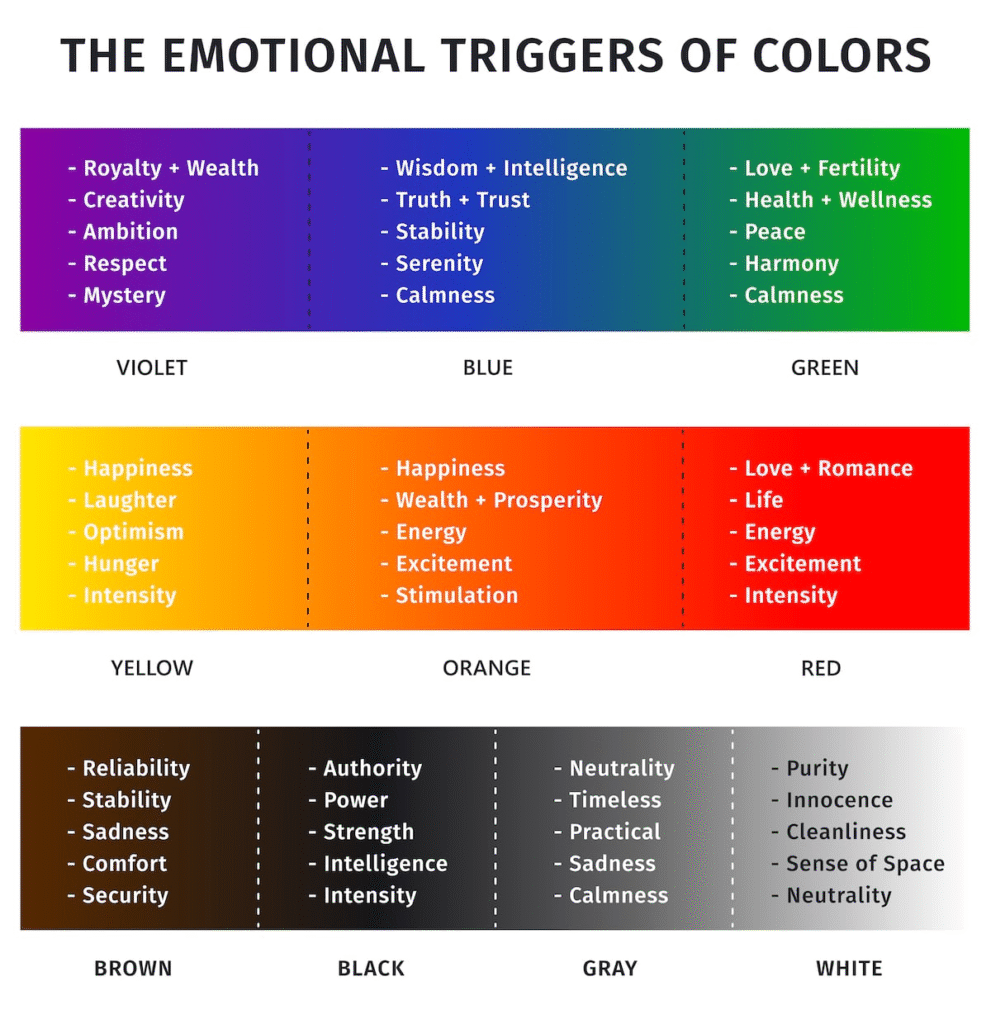
Understanding how colors affect mood and behavior can guide your creative children’s room decor choices:
Energizing Colors (Use Sparingly):
- Red: Stimulates activity but can overstimulate
- Orange: Promotes enthusiasm and creativity
- Bright Yellow: Encourages happiness but can cause anxiety in large doses
Calming Colors (Great for Sleep Areas):
- Blue: Promotes calm and focus
- Green: Balances energy, promotes growth
- Purple: Encourages imagination and creativity
Neutral Foundations:
- White/Cream: Clean, adaptable, timeless
- Gray: Modern, sophisticated, grows with kids
- Beige: Warm, comforting, natural
Our approach: Use neutrals for expensive items (furniture, flooring) and add personality through easily changeable elements (bedding, wall art, accessories).
Technology Integration in Modern Kids’ Rooms 💻
Today’s DIY kids room ideas need to account for technology without letting it dominate:
Smart Integration:
- Charging stations: Built into desks or nightstands
- Cable management: Hidden cord systems
- Lighting control: Smart bulbs for reading vs. relaxation
- Sound systems: Built-in or wireless speakers for music
Screen Time Balance:
- Device-free zones: Especially sleeping areas
- Homework areas: Minimal distractions, focused environment
- Family time spaces: Encourage interaction over isolation
Future-Proofing:
- Flexible outlets: More than you think you need
- Adaptable furniture: Pieces that work with changing technology
- Wire management: Systems that can evolve
Involving Extended Family in Room Projects 👨👩👧👦
Some of our most meaningful DIY children’s bedroom decorating projects have involved grandparents, aunts, uncles, and family friends:
Grandparent Projects:
- Memory quilts: Using fabric from outgrown clothes
- Photo displays: Creating family history walls
- Handmade furniture: Simple pieces with sentimental value
- Story corners: Recording family stories for bedtime
Sibling Collaboration:
- Shared projects: When kids work together on room improvements
- Skill sharing: Older kids teaching younger ones
- Room swaps: Helping each other with updates
- Family room projects: Spaces that serve multiple kids
Community Involvement:
- Skill exchanges: Trading expertise with other families
- Group purchases: Buying materials in bulk for better prices
- Project parties: Making room updates social events
This approach builds relationships while creating spaces, and kids learn that homes are built by communities, not just individual effort.
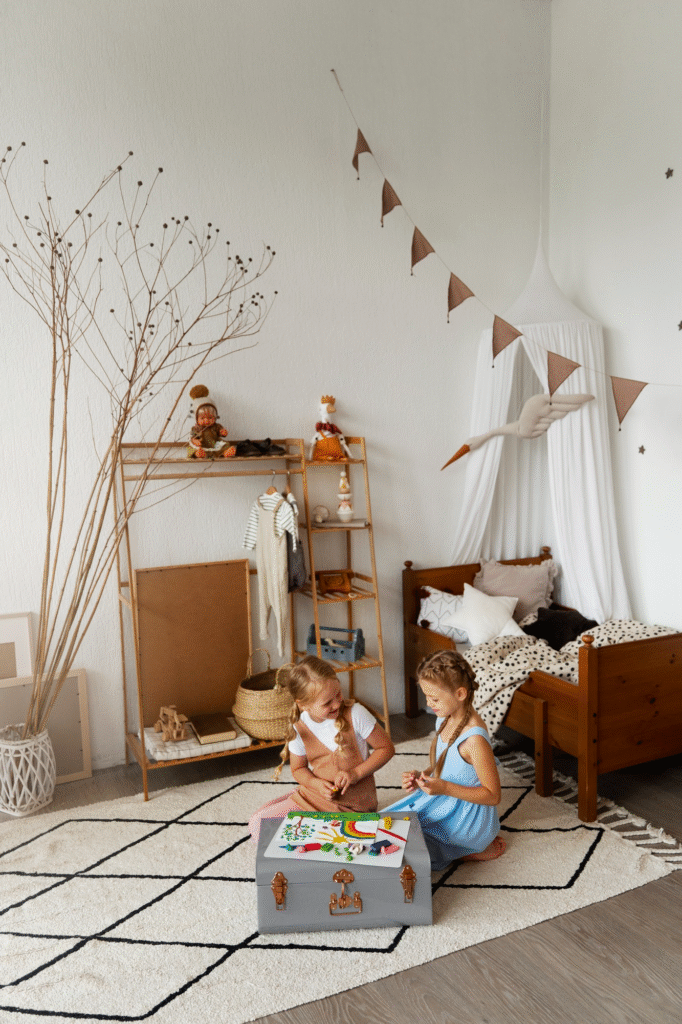
Seasonal Deep Dives: Specific Project Ideas 🗓️
Let me share some budget-friendly kids bedroom projects we tackle during specific times of year:
January: Organization Overhaul
After holidays, kids’ rooms need major organization attention:
- Toy purge and sort: Donate unused items, organize keepers
- Closet reorganization: Accommodate new clothes, outgrown items
- Study area setup: Prepare for spring semester needs
- Goal-setting displays: Visual reminders of new year intentions
March: Spring Cleaning Projects
- Deep cleaning: Walls, baseboards, forgotten corners
- Maintenance checks: Tighten loose screws, touch up paint
- Air quality improvement: Wash bedding, check ventilation
- Growth assessments: What’s working, what needs changing
June: Summer Project Planning
- Major updates: Projects that require time and focus
- Outdoor integration: Bringing outdoor elements inside
- Activity preparation: Setting up for summer activities
- Independence encouragement: Systems kids can maintain themselves
September: Back-to-School Setup
- Study optimization: Improving homework and project spaces
- Schedule systems: Visual calendars and planning tools
- Supply organization: Creating systems for school materials
- Morning routine support: Spaces that help kids get ready independently
Building Life Skills Through Room Projects 🎯
The best DIY kids room ideas teach valuable life skills:
Planning and Problem-Solving:
- Measuring spaces: Math in action
- Budget management: Understanding costs and priorities
- Project planning: Breaking big tasks into manageable steps
- Creative problem-solving: Finding solutions when things don’t go as planned
Practical Skills:
- Tool use: Safe, age-appropriate instruction
- Organization systems: Creating and maintaining order
- Cleaning and maintenance: Taking care of belongings
- Design principles: Understanding what works and why
Life Values:
- Ownership and responsibility: Caring for your space
- Creativity and self-expression: Finding your unique style
- Collaboration: Working with others toward common goals
- Resourcefulness: Making the most of what you have
These skills serve kids far beyond their childhood rooms. We’re raising future homeowners, apartment renters, college students, and adults who will create their own spaces someday.
Common Challenges and Realistic Solutions 💪
Let’s address the real challenges of implementing kids room makeover ideas:
Challenge: Limited Space
Reality: Many families deal with small rooms or shared spaces.
Solutions:
- Vertical storage: Use wall space for organization
- Multi-functional furniture: Pieces that serve double duty
- Defined zones: Create separate areas within small spaces
- Visual tricks: Light colors and mirrors to expand feeling of space
Challenge: Rental Restrictions
Reality: Many families can’t make permanent changes.
Solutions:
- Removable options: Adhesive hooks, temporary wallpaper, furniture-based storage
- Portable improvements: Items that can move with you
- Damage-free hanging: Command strips and other landlord-friendly options
- Furniture-based solutions: Changes that don’t affect walls or floors
Challenge: Multiple Kids, Different Ages
Reality: Siblings often share rooms despite different needs and interests.
Solutions:
- Personal zones: Giving each child defined space
- Flexible systems: Storage and organization that works for various ages
- Compromise decorating: Finding common ground in design choices
- Growth planning: Systems that adapt as kids mature
Challenge: Maintenance and Cleanliness
Reality: Kids’ rooms get messy quickly.
Solutions:
- Simple systems: Easy enough for kids to maintain independently
- Reasonable expectations: Not every moment needs to be Pinterest-perfect
- Regular resets: Scheduled times for deeper cleaning and organization
- Sustainable habits: Building routines that become automatic
Real Talk: When DIY Isn’t the Answer 🤔
Sometimes, DIY kids room ideas aren’t the best solution:
When to Consider Professional Help:
- Electrical work: Safety requires expertise
- Structural changes: Wall removal, major alterations
- Plumbing modifications: Adding or moving water sources
- Complex built-ins: Projects requiring precision and experience
When to Buy Instead of DIY:
- Safety equipment: Cribs, car seats, other regulated items
- Complex mechanisms: Items with moving parts or precision requirements
- Time constraints: When your schedule doesn’t allow for project completion
- Skill limitations: Projects beyond your current abilities
When Simple Solutions Work Better:
- Temporary needs: Solutions for short-term situations
- Rental situations: When permanent changes aren’t allowed
- Budget constraints: When materials cost more than finished products
- Child resistance: When kids aren’t interested in DIY involvement
Remember: The goal is creating spaces kids love, not proving DIY prowess.
Documenting the Journey: Creating Lasting Memories 📸
Inspiration like these IKEA hacks for kids’ rooms helped us create spaces that evolved with our children.:
Photo Documentation:
- Before and after: Showing dramatic transformations
- Process shots: Kids involved in projects
- Detail photos: Close-ups of special elements
- Growth progression: How rooms evolved over time
Project Journals:
- Planning sketches: Kids’ ideas and dreams
- Budget tracking: Learning about costs and priorities
- Timeline records: How long projects actually took
- Lesson learned: What worked, what didn’t
Memory Integration:
- Photo displays: Including project photos in room decor
- Story books: Creating narratives about room evolution
- Time capsules: Preserving mementos from different room phases
- Family traditions: Annual room updates or seasonal changes
My kids often look back at photos of their rooms from previous years, amazed at how their tastes and needs have changed. It’s become a visual representation of their growth and development.
Budget Hacks: Getting More for Less 💰
Real budget-friendly kids bedroom wisdom comes from experience:
Timing Your Purchases:
- End-of-season sales: Buy summer items in fall, winter items in spring
- Back-to-school clearance: Great for organization supplies
- Post-holiday sales: Decorative items at deep discounts
- Moving season bargains: May and August bring great secondhand finds
Resource Maximization:
- Repurposing items: Finding new uses for existing pieces
- Skill bartering: Trading abilities with other families
- Bulk purchasing: Joining with friends for better prices
- Free resources: Community programs, library tools, online tutorials
Investment Prioritization:
- Quality for frequently used items: Beds, desks, storage systems
- Budget for temporary elements: Decorative items, bedding, wall art
- Safety first: Never compromise on structural or safety features
- Flexibility focus: Choose adaptable over specific
Money-Saving Partnerships:
- Family collaboration: Grandparents, aunts, uncles contributing skills or funds
- Friend networks: Sharing tools, skills, and bulk purchases
- Community resources: Local maker spaces, library tool lending
- School connections: Teacher discounts, bulk supply purchases
Maintaining Your DIY Investments 🔧
Creative children’s room decor requires ongoing attention:
Regular Maintenance Schedule:
- Weekly: Basic cleaning and organization
- Monthly: Deep cleaning and minor repairs
- Seasonally: Major organization and updates
- Annually: Assessment and major changes
Teaching Kids Maintenance:
- Age-appropriate responsibilities: What kids can handle independently
- Tool education: Safe use of basic repair tools
- System understanding: How organization systems work
- Pride development: Connection between care and longevity
Upgrade Planning:
- Gradual improvements: Small enhancements over time
- Needs assessment: What’s working, what needs changing
- Growth accommodation: Adapting to changing needs
- Budget planning: Saving for larger improvements
Family routines that work often include regular room maintenance as part of larger household systems.
Conclusion: Creating Spaces That Matter 🏠
After six kids, countless room projects, and more Pinterest fails than I care to admit, here’s what I’ve learned about DIY kids room ideas:
The perfect room doesn’t exist.
What exists is the perfect room for your child, right now, with the resources you have available.
Some of our most treasured room features came from necessity, creativity, and budget constraints rather than unlimited funds and perfect planning. The chalkboard wall in Melody’s room happened because we couldn’t afford new wallpaper. The reading nook in Gabrielle’s space came from a pile of pillows and string lights when her ceiling light burned out.
Kids don’t need perfect spaces – they need spaces that reflect love, creativity, and attention to their individual personalities.
Every successful budget-friendly kids bedroom project we’ve completed had these elements:
- Kid involvement in planning and execution
- Realistic expectations about timelines and outcomes
- Flexibility to adapt when things didn’t go as planned
- Focus on function over magazine-worthy aesthetics
- Safety as the non-negotiable priority
The goal isn’t to create a space that impresses other adults. The goal is to create a space where your child feels seen, valued, and at home.
Your Next Steps 🚀
Ready to start your own kids room makeover ideas journey? Here’s where to begin:
Week 1: Assessment and Planning
- Talk with your kids about their dreams and needs
- Assess your current space honestly
- Set a realistic budget (remember, you can phase projects)
- Choose your first project (start small!)
Week 2: Preparation
- Gather materials for your chosen project
- Prepare the workspace safely
- Set realistic timelines (everything takes longer than expected)
- Plan for involvement of kids at appropriate levels
Week 3-4: Project Execution
- Start with safety setup
- Work in manageable chunks (don’t try to do everything at once)
- Document the process for memories
- Celebrate small wins along the way
Moving Forward
- Evaluate what worked and what didn’t
- Plan your next project based on lessons learned
- Maintain what you’ve created with regular attention
- Adapt as needs change – and they will!
Remember: every expert was once a beginner. Your first project doesn’t have to be perfect. It just has to be yours.
More importantly: involve your kids, enjoy the process, and create memories that will last far longer than any particular room design.
God Bless, and happy creating! ✨
What DIY kids room ideas are you most excited to try? Which of your kids do you think will be most involved in the process? Remember – the journey matters just as much as the destination.
🌐 Explore More from Our Family of Blogs
If you found this article helpful, you might also enjoy what we’re sharing across our other platforms. Each one is designed to uplift, equip, and inspire families in real, practical ways:
🏠 Mountains Will Move
Faith-based encouragement for everyday families. We dive into prayer, parenting, purpose, and pressing through life’s hardest seasons with Jesus at the center.
👉 Visit Mountains Will Move »
🔎 Everyday Exposed
Our no-filter truth hub—where we tackle myths, challenge misleading narratives, and bring clarity to the conversations that matter most.
👉 Visit Everyday Exposed »
Whether you’re diving deeper into pet care, faith, or uncovering truth in today’s noisy world, I hope you’ll journey with us.
Thank you for being part of the community. God Bless you and your family. 🙏
